A Pattern Language for Costumes in Films - IAAS
A Pattern Language for Costumes in Films - IAAS
A Pattern Language for Costumes in Films - IAAS
Create successful ePaper yourself
Turn your PDF publications into a flip-book with our unique Google optimized e-Paper software.
and their bus<strong>in</strong>ess processes require more <strong>in</strong>vestigation. The focus <strong>in</strong> our work with<strong>in</strong> the broad scope of film<br />
mak<strong>in</strong>g and film analysis is set on the wardrobe department, which is responsible <strong>for</strong> the creation and<br />
management of costumes. Here, several problem doma<strong>in</strong>s exist: The doma<strong>in</strong> of costume design and the<br />
research on vestimentary communication <strong>in</strong> media science that is associated with it, the doma<strong>in</strong> of costume<br />
management <strong>for</strong> sell<strong>in</strong>g and lend<strong>in</strong>g costumes, the doma<strong>in</strong> of tailor<strong>in</strong>g costumes and pieces of cloth<strong>in</strong>g, and<br />
the doma<strong>in</strong> of practical usage of costumes at a film set. Given these particular problem doma<strong>in</strong>s and<br />
narrowed scope, we conducted a literature survey to get a thorough understand<strong>in</strong>g of current practice and<br />
science of costume design, available tool offer<strong>in</strong>gs, and related pattern approaches. The ma<strong>in</strong> results of this<br />
survey are described <strong>in</strong> the follow<strong>in</strong>g. In order to <strong>in</strong>crease transparency of our research and <strong>for</strong> traceability of<br />
the results we achieved, we subsequently describe our research design.<br />
3.1 Literature Survey<br />
Regard<strong>in</strong>g the doma<strong>in</strong> of costume design and related research, the ma<strong>in</strong> problem is to design a costume that<br />
reflects the place and time of play as well as it has to show understand<strong>in</strong>g of the characteristics of the role,<br />
actor and screenplay overall. Complex aspects of vestimentary communication need to be considered. For<br />
example, physical requirements imposed on the costume like protection from high or low temperature need<br />
to be arranged with social expectations of the film audience and stereotypes tra<strong>in</strong>ed through media<br />
socialization. Although costumes are a very important aspect <strong>in</strong> a film and although fashion and cloth<strong>in</strong>g<br />
have been more <strong>in</strong>tensively discussed s<strong>in</strong>ce the 1980s [2] [8] [18], the discussion of costumes <strong>in</strong> media<br />
science is still limited. Research was made <strong>in</strong> the course of the Mise-en-scène analysis [19], focus<strong>in</strong>g on the<br />
communicative aspect [20], <strong>in</strong>vestigat<strong>in</strong>g the sign character of a costume [8], and discuss<strong>in</strong>g the relation<br />
between costumes and femaleness [21]. The term of a ‘costume language’ is used <strong>in</strong> many of these works,<br />
however metaphorically. Without neglect<strong>in</strong>g the communicative aspect of cloth<strong>in</strong>g, the current state <strong>in</strong><br />
research is that a common costume language is hard to develop due to the complex relationships of cultural,<br />
social, and situational aspects [8] [22] [23]. Barthes [2] developed an <strong>in</strong>ventory system to describe the most<br />
significant aspects of clothes and to decompose them <strong>in</strong>to their constituent parts. Burger [8] made this system<br />
accessible to film costumes. Though, to the best of our knowledge, there is still no <strong>for</strong>mal approach <strong>in</strong> terms<br />
of a well-def<strong>in</strong>ed syntax and semantics to make costumes ready <strong>for</strong> process<strong>in</strong>g <strong>in</strong> <strong>in</strong><strong>for</strong>mation systems.<br />
The lack of an established <strong>for</strong>mat is also reflected <strong>in</strong> the next doma<strong>in</strong>, costume management. Current tools<br />
are provid<strong>in</strong>g support <strong>for</strong> documentation, adm<strong>in</strong>istration and <strong>in</strong>ventory <strong>for</strong> costumes as a monolithic entity.<br />
Although the pieces of cloth<strong>in</strong>g a costume is composed of are known, this level of detail is not yet reached <strong>in</strong><br />
practice. Prom<strong>in</strong>ent examples <strong>for</strong> such tools are go_disco [15] and Pro Fundus [16]. In current practice,<br />
either the <strong>for</strong>mat that a tool is us<strong>in</strong>g is applied or an <strong>in</strong>dividually def<strong>in</strong>ed <strong>for</strong>mat is used. Due to the lack of an<br />
established <strong>for</strong>mat, there is no <strong>in</strong>tegrated electronic marketplace where structured costumes can be ordered<br />
<strong>for</strong> buy<strong>in</strong>g or lend<strong>in</strong>g.<br />
Regard<strong>in</strong>g the doma<strong>in</strong> of tailor<strong>in</strong>g, the ma<strong>in</strong> problems are how to cut particular fabrics and how to sew them<br />
to obta<strong>in</strong> a piece of cloth<strong>in</strong>g. In fact, this doma<strong>in</strong> makes use of so-called ‘sew<strong>in</strong>g patterns’. The approach of<br />
sew<strong>in</strong>g patterns evolved <strong>in</strong> the second half of the 19 th century giv<strong>in</strong>g also non-<strong>in</strong>dustrials the opportunity to<br />
represent and reuse a good composition of pieces of fabrics which can be sewed up to a piece of fashionable<br />
cloth<strong>in</strong>g [11]. Basically, sew<strong>in</strong>g patterns are cutt<strong>in</strong>g and sew<strong>in</strong>g templates which describe the shapes of the<br />
different elements of a piece of cloth<strong>in</strong>g [12]. Nowadays, sew<strong>in</strong>g patterns still play an important role <strong>in</strong> the<br />
doma<strong>in</strong> of tailor<strong>in</strong>g, both <strong>in</strong> <strong>in</strong>dustrial practice and <strong>in</strong> the daily bus<strong>in</strong>ess of tailors work<strong>in</strong>g <strong>in</strong> film<br />
productions and theatres. There is a number of sew<strong>in</strong>g pattern catalogs available, <strong>for</strong> example the Burda<br />
catalog [13], the Vogue patterns [14], or the COPA archive [17]. Recently, simulation systems have emerged<br />
<strong>in</strong> which sew<strong>in</strong>g patterns can be tested virtually. For example, <strong>in</strong> [25] sew<strong>in</strong>g patterns can be placed around a<br />
three-dimensional body. An <strong>in</strong>tegrated simulation system then computes the result of the sew<strong>in</strong>g process to<br />
provide a so-called ‘virtual try-on’ to <strong>in</strong>crease the efficiency of the design process. In the follow<strong>in</strong>g, we refer<br />
to sew<strong>in</strong>g patterns as sew<strong>in</strong>g templates to make the discrim<strong>in</strong>ation towards costume patterns more clear.<br />
These templates can be seen as additional <strong>in</strong><strong>for</strong>mation as guidance <strong>for</strong> a tailor.<br />
Regard<strong>in</strong>g the doma<strong>in</strong> of practically work<strong>in</strong>g with costumes on a film set, the problems are rather<br />
operational. For example, a problem is how to dress a particular actor with a given costume. For many<br />
costumes the operational knowledge is already available from daily life. For <strong>in</strong>stance, the order of apply<strong>in</strong>g a<br />
shirt, trousers, socks, and shoes to an actor is quite clear. However, what about the order of dress<strong>in</strong>g a<br />
complex uni<strong>for</strong>m costume? For example, the uni<strong>for</strong>m of a ‘Stormtrooper’ costume from the movie series<br />
7
















